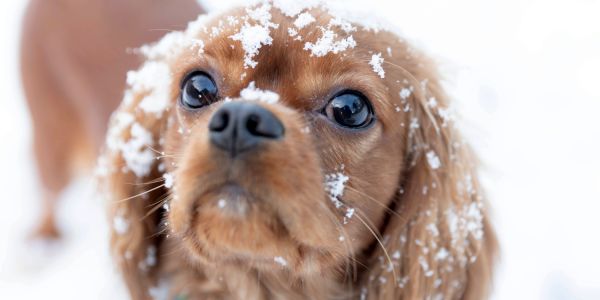Dogs and snow - what to consider?

15.12.2021
Here it comes - the most peaceful of all seasons with a special characteristic: snow. For some four-legged friend it is the greatest phenomenon there is, for another it is the epitome of wet paws and discomfort. It's important to make sure that snow doesn't bring any negative consequences for your furry friend. For most dogs, the first snow is something very special: but epecially new dog owners are faced with various questions, which we would like to answer:
How long can my dog stay in the snow?
This depends somewhat on the outside temperatures. In general, however, snow stands for cold and this should always be treated with caution. Even if the sun is shining and you find the outside temperature bearable, keep in mind: less is often more! It's better to go out more often and warm up properly in between than to walk around on frosty ground for too long. The hard and cold ground strains your dog's sensitive paws and can lead to unpleasant injuries. The best thing to do is to put paw pads on your dog. But if he doesn't like them at all, you can rub a paw protection cream or Vaseline on his paws before and after each walk to protect them better. Special care should be taken with road salt, as this can be quite unpleasant for the dog to get stuck between the paw pads. The same often applies to icy bits. You should remove these after the walk directly.
My dog eats snow - is that dangerous?
Snow is just cold water, right? In principle, yes and no. Because snow is not only cold, but also very dirty water and often full of road salt! Therefore you should rather stop snow eating in case of doubt. All kinds of bacteria can hide in the snow, which looks so clean, and can quickly lead to gastritis, an inflammation of the stomach lining. This brings unpleasant abdominal pain and diarrhea with it, which can last up to two weeks. If your dog can't be let off the snow snack at all, you should consider to go for a walk in places as free of snow as possible. Of course, if your dog is muzzle trained, this is also a way to keep him from eating snow.
Why do most dogs find snow so great in the first place?
Many dog owners know it - as soon as their paws touch the snow, the dog gets his "great five minutes" and runs back and forth like crazy. But why is it like that? It is probably due to the heritage: the dog still carries the wolf in him and snow means safe prey for wolves. Paw prints and intense smells mean fun, for example following tracks or sniffing out rabbit burrows. In addition, snow is simply an extraordinary condition for the dog, because on average there is just 15 to 30 days of snow in Germany. Thus, it is every time a very special experience for each of them.
Does my dog have special needs in winter?
Probably yes. In the winter, especially in the snow, dogs tend to wear themselves out much more. In addition, the cold temperatures cause dogs to need significantly more energy than in the rest of the months. So it's helpful for a dog to get a little chubby. The extra layer of fat helps to survive the cold temperatures. But, you have to pay attention that it is not too much winter fat and that it disappears quickly in spring. For older or short-haired dogs that have little undercoat, a coat can be quite helpful to keep the cold and the cold wetness away that comes with the snow.
We hope we have answered the major questions about dogs in the snow for you. The most important thing, as always, is to have fun together and pay attention to the needs of your dog. So go ahead and enjoy the upcoming snow season to the fullest!








